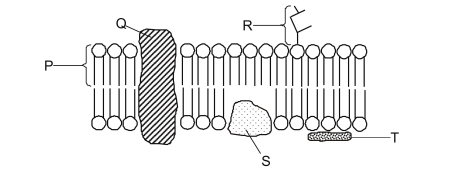The diagram below represents the fluid mosaic model of the cell (surface) membrane.

Only two of the labelled molecules have both hydrophobic and hydrophilic areas. Which two molecules are they?
A. P and Q
B. R and S
C. Q and R
D. S and T
E. P and T
1 Like
The answer to this question is A, wherein molecules P & Q have hydrophobic and hydrophilic areas.
Before you answer this question, you must first be oriented to a few concepts, which will help you understand the diagram more efficiently:
- Hydrophilic properties means that the molecules are attracted to water or aqueous environments.
- Hydrophobic properties on the other hand means that the molecules repel, or are not compatible with water.
- The diagram given in the question shows a model of the cell membrane. It is important to note that on either side of this membrane, the environment is aqueous or watery. Which means that the core of this membrane is hydrophobic. With this in mind, you are to find the 2 molecules that are involved with both the hydrophobic and hydrophilic areas of the membrane.
As mentioned above, the 2 correct molecules are P and Q, let’s discuss all molecules as to why it is or is not the correct answer.
-
P is one of the correct molecules. This is because P is a phospholipid. It is important to remember the 2 main parts of a phospholipid, which is the head and the 2 tails. The head is made up of a phosphate molecule, which gives it a hydrophilic property. The tails on the other hand are fatty acids, which are hydrophobic, which explains why they are oriented away from the aqueous environment. This makes up the hydrophobic core of the cell membrane.
-
Q is one of the correct molucules. This is an integral protein, which means that this kind of protein spans the whole cell membrane. This means that it has both hydrophilic and hydrophobic properties, to allow itself to interact and be anchored with the hydrophobic core of the membrane, and at the same time, to allow itself to stick out on either side of the membrane. where it is exposed to the aqueous environment.
-
R, S, and T are not the correct answers. If you notice, these are peripheral proteins, and are found either completely outside of the membrane, or are loosely attached within the membrane itself. R and T are exposed only to the aqueous environment, with no interaction at all with the hydrophobic core of the membrane, which already eliminates these 2 molecules. For molecule S, do not be confused, you might be tempted to include this as an answer, but notice how the molecule is not embedded deep inside the lipid layer (the hydrophobic layer), but instead there is a space. This suggests that this molecule is repelling the lipid layer, and has mostly hydrophilic properties.
2 Likes
